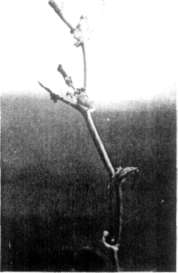38
PNL Volume 20
1988 RESEARCH
REPORTS
RUINOUS (rui): NEW COMPLEX, STERILE
GENE
Swiecicki, W. K.
Plant Breeding Station, Wiatrowo, Poland
The pea genome contains a group of mutants
characterized as "complex with extensive pleiotropic effects" (1). This
group includes mutants that control leaf shape and/or size, or general
plant habit, but the main characteristic is complete sterility due to
drastically changed generative organs. Lamprecht (2) named them
interspecific genes and considered them important from a phylogenetic
point of view. In his opinion such genes cannot mutate to a different allele without the loss of
reproductive ability . Angustifolius, filiformis,
laciniate, obovatus, or unifo-liate�maintained as
heterozygotes � are examples of this group of mutants. Using Nf, NEU, and
a combined dose of these mutagens on seeds of two lines, Wt 3527 and Wt
4042, a few mutation cases of the same type were found in the M2
(segregating) generation (3). Plants were extremely reduced in length and
the stems and leaf petioles look as if burned or pecked by birds (Fig. 1).
Mendelian, recessive inheritance with a deficit of recessives was observed
in M2, M3, and M4. On this basis I propose the name ruinous and the
symbol rui for the mutation type and the gene, respectively.
Heterozygous Lines with the gene rui appear in the gene bank under
the following
numbers:
Wt 15046, from 'Kaliski', 500r
Nf,
Wt 15047, from Kaliski, 0.014% NEU,
Wt 15043, from 'Paloma', 0.014%
NEU,
Wt 15044, from Paloma, 200r
Nf/0.0l4% NEU. Mapping of the complex, sterile mutants presents
difficulties. Sterility and the need to cross heterozygotes are only part
of the problem. In mutants such as fil and rui, there
is also a deficiency of mutant segregants and the phenotype interferes
with marker expression. We
intend to use isozyme markers to reduce the problem.

1. Blixt, S. Agri Hort. Genet.
30.
2. Lamprecht, H. 1974. Monographic:
der Gattung Pisum,
Graz.
3. Swiecicki, W. K. 1985. PNL
17:
72-74.
Fig. 1. Ruinous mutation type.
*****